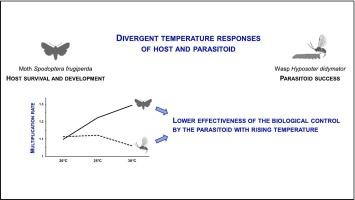Divergent responses of the fall armyworm and a parasitoid to rising temperature
IF 3.4
2区 农林科学
Q2 BIOTECHNOLOGY & APPLIED MICROBIOLOGY
引用次数: 0
Abstract
Temperature is a key factor influencing insect performance and host-parasitoid interactions. Knowing how hosts and parasitoids respond to temperature variations is crucial for predicting the success of biological control strategies, especially in the context of climate change. This study aimed to assess how developmental temperature affects the interaction between the fall armyworm (FAW) Spodoptera frugiperda, a major invasive pest, and the larval endoparasitoid Hyposoter didymator. FAW caterpillars were reared under three fluctuating temperature regimes centered at 20 °C, 25 °C, and 30 °C (± 5°C of daily variation), and were either left unexposed or exposed to H. didymator. We analyzed host survival, developmental time, and body mass, as well as the success of the parasitoid. In unparasitized FAW, higher temperatures accelerated development and increased pupal survival but reduced larval survival and adult body mass. In parasitized FAW, the proportion of individuals that survived increased at 30 °C, suggesting that higher temperatures may undermine the biological control of this pest. For H. didymator, temperature accelerated development but had negative effects at 30 °C, leading to reduced survival during the endoparasitic phase and impaired cocoon formation. These contrasting responses led to opposite trends: the multiplication rate of FAW increased with temperature, while that of the parasitoid decreased at the highest temperature. This study underscores the importance of considering the thermal sensitivity of both FAW and its potential parasitoids when designing effective and sustainable pest management strategies.

秋粘虫和一种拟寄生虫对温度升高的不同反应
温度是影响昆虫生产性能和寄主-寄生蜂相互作用的关键因素。了解寄主和拟寄生虫对温度变化的反应对于预测生物防治策略的成功至关重要,特别是在气候变化的背景下。本研究旨在探讨发育温度对主要入侵害虫——秋粘虫(Spodoptera frugiperda)与幼虫类内寄生双动力拟虫(Hyposoter didymator)相互作用的影响。在以20°C、25°C和30°C为中心(每日变化±5°C)的三种波动温度条件下饲养一汽毛虫,要么不暴露,要么暴露于双足赤蛾。我们分析了寄主的存活率、发育时间和体重,以及寄生蜂的成功。在未寄生的FAW中,较高的温度加速了发育并增加了蛹的存活率,但降低了幼虫的存活率和成虫的体重。在30°C的温度下,被寄生的FAW的存活率增加,表明较高的温度可能会破坏该害虫的生物控制。温度在30°C时加速了双角圆蝽的发育,降低了其在寄生期的存活率和成茧能力。这些不同的响应导致了相反的趋势:FAW的繁殖率随温度升高而增加,而寄生蜂的繁殖率在最高温度下下降。该研究强调了在设计有效和可持续的害虫管理策略时考虑FAW及其潜在寄生蜂的热敏性的重要性。
本文章由计算机程序翻译,如有差异,请以英文原文为准。
求助全文
约1分钟内获得全文
求助全文
来源期刊

Biological Control
生物-昆虫学
CiteScore
7.40
自引率
7.10%
发文量
220
审稿时长
63 days
期刊介绍:
Biological control is an environmentally sound and effective means of reducing or mitigating pests and pest effects through the use of natural enemies. The aim of Biological Control is to promote this science and technology through publication of original research articles and reviews of research and theory. The journal devotes a section to reports on biotechnologies dealing with the elucidation and use of genes or gene products for the enhancement of biological control agents.
The journal encompasses biological control of viral, microbial, nematode, insect, mite, weed, and vertebrate pests in agriculture, aquatic, forest, natural resource, stored product, and urban environments. Biological control of arthropod pests of human and domestic animals is also included. Ecological, molecular, and biotechnological approaches to the understanding of biological control are welcome.
 求助内容:
求助内容: 应助结果提醒方式:
应助结果提醒方式:


